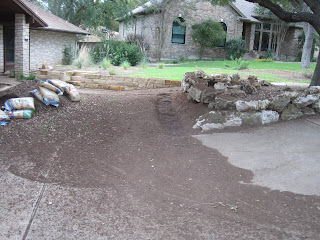The live oak planted in the front yard, between the driveway and the sidewalk we call Fuzzy. The last section of the house to dig up is from Fuzzy to the house.
Our experience with the Spanish Oak in the front yard, and, to a lesser extent, the Monterrey Oak in the back, is that trees are not happy when you dig around their roots, and even when you try to stay well back, they can die. We don't want that to happen to Fuzzy, so we want to be very careful of it's roots while planning and digging.
Our plan is to terrace the area under Fuzzy, just as we did on the main front yard, so that we provide more, better, dirt for Fuzzy's roots. We have a temporary retaining wall around it, and just need to make that permanent.
What do we need to protect, in terms of Fuzzy's roots? Searching, we find something called the Critical Root Zone. The Critical Root Zone for a tree shows how far out you need to be to preserve the roots.
This picture is for a 20-inch diameter tree; Fuzzy is about 22 inches, so measures should be about 10% more. But certainly 1/2 CRZ at 11 feet is a point we should try not to disturb. Which means we can put our retaining wall at 11 feet (from Fuzzy).
We marked off where the wall would go then.
But to put the wall here, we need to know where the major roots are, so that we do not damage them in the construction of the wall. And this is where Air Spading comes in.
Air Spading is basically using high pressure air to break up and move the dirt. While it is enough force to break up the dirt, it is not enough to hurt the roots, so it removes the dirt, but leaves the roots. It basically is like a high pressure washer, but with air instead of water. It takes a big compressor and a special air spading nozzle.
There are a couple of companies in town that advertise they do air spading. We contacted two. The person from the first company was uncertain how it worked, and what it was for, so they priced it at $350 for the first hour and $150 for each hour after that. The second company, Good Guys Tree Service, understood what I wanted, and priced it at $700. We went with Good Guys, since they apparently had more experience. Their estimate said:
"PLEASE NOTE THE FOLLOWING: Airspading is a necessarily dusty and messy task that is designed to protect and prevent damage to the tree's root system. Dirt particulates, small rocks and materials may be jetted up to 50' from project area. Large Stones, Objects, or any other discoveries that will not be displaced by the air jet will be left as found. Exposed roots should be re-covered with a light layer no more then 3/4" thick of hardwood mulch within 2 weeks of airspade exposure."
They took about an hour to do the work. They showed up with a pick-up truck towing a large compressor, attached a hose to the compressor, and the air spade to the hose and went to work.
The result was a trench blown out of the dirt, exposing the roots. Dirt everywhere!
(I expect that the soil being pretty dry helped.)
This exposes the root very well. We can see that there are some large roots, especially on both ends of the trench.
while other sections have much smaller roots.






























